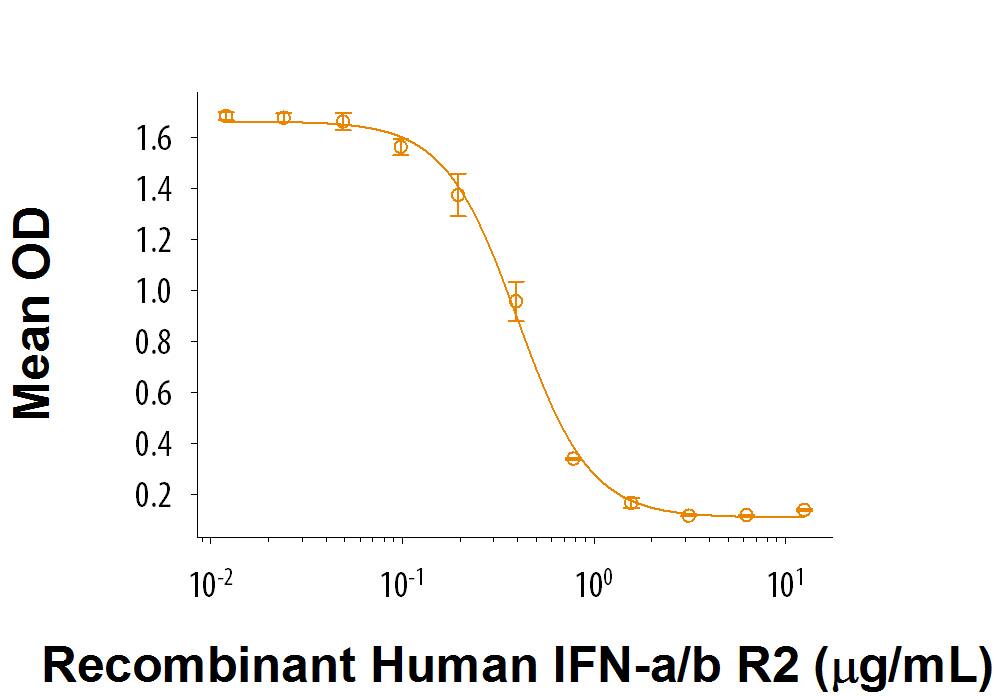Recombinant Human IFN-alpha/beta R2 Fc Chimera Protein, CF
R&D Systems, part of Bio-Techne | Catalog # 4015-AB

Key Product Details
Source
Accession #
Structure / Form
Conjugate
Applications
Product Specifications
Source
| Human IFN-alpha / beta R2 (Ile27-Lys243) Accession # P48551 |
IEGRMD | Human IgG1 (Pro100-Lys330) |
| N-terminus | C-terminus |
Purity
Endotoxin Level
N-terminal Sequence Analysis
Predicted Molecular Mass
SDS-PAGE
Activity
The ED50 for this effect, as measured by inhibition of Recombinant Human IFN‑ beta (Catalog # 8499-IF) , is 0.1-0.6 μg/mL
Scientific Data Images for Recombinant Human IFN-alpha/beta R2 Fc Chimera Protein, CF
Recombinant Human IFN-alpha/beta R2 Fc Chimera Protein Bioactivity
Recombinant Human IFN-alpha/beta R2 Fc Chimera (Catalog # 4015-AB) inhibits the anti-viral activity of Recombinant Human IFN-beta (Catalog # 8499-IF). The ED50 for this effect is 0.1-0.6 μg/mL.Formulation, Preparation and Storage
4015-AB
| Formulation | Lyophilized from a 0.2 μm filtered solution in PBS. |
| Reconstitution |
Reconstitute at 500 μg/mL in sterile PBS.
|
| Shipping | The product is shipped at ambient temperature. Upon receipt, store it immediately at the temperature recommended below. |
| Stability & Storage | Use a manual defrost freezer and avoid repeated freeze-thaw cycles.
|
Background: IFN-alpha/beta R2
IFN-alpha / beta R2, also known as IFNAR2, is a 100 kDa glycoprotein in the class II cytokine receptor family. These proteins form heterodimeric receptor complexes that transduce signals from the interferon, IL-10, and IL-28 families of cytokines (1, 2). IFN-alpha / beta R2, in association with IFN-alpha / beta R1, is required for mediating the antiviral, antiproliferative, and apoptotic effects of the type I interferons IFN-alpha and IFN-beta. IFN-alpha / beta R2 is the principal ligand binding subunit of the receptor. Ligand binding is stabilized by the subsequent association with IFN-alpha / beta R1, resulting in the formation of a signaling ternary receptor complex (3, 4). Mature human IFN-alpha / beta R2 consists of a 217 amino acid (aa) extracellular domain (ECD) with two fibronectin type III repeats, a 21 aa transmembrane segment, and a 251 aa cytoplasmic domain. Alternate splicing generates a secreted isoform that corresponds to the ECD and a 50 kDa transmembrane isoform with a substituted and truncated cytoplasmic region (5, 6). The short isoform is impaired in its ability to activate signaling molecules and functions as a dominant negative receptor subunit (7 - 9). IFN-alpha / beta R2 is also subject to presenilin-dependent intramembrane proteolysis, resulting in the liberation of nearly the entire ECD as well as the cytoplasmic domain which migrates to the nucleus and can inhibit gene transcription (10). High concentrations of soluble IFN-alpha / beta R2 bind and neutralize IFN-alpha and IFN-beta, while lower concentrations prolong the antiviral activity of circulating IFN-beta but not IFN-alpha (11). Human but not mouse IFN-alpha / beta R2 constitutively associates with STAT4, which may account for species specific differences observed in type I interferon responses (12). Within the ECD, human IFN-alpha / beta R2 shares 63%, 60%, and 48% aa sequence identity with bovine, mouse, and ovine IFN-alpha / beta R2, respectively.
References
- Langer, J.A. et al. (2004) Cytokine Growth Factor Rev. 15:33.
- Pestka, S. et al. (2004) Immunol. Rev. 202:8.
- Lamken, P. et al. (2004) J. Mol. Biol. 341:303.
- Arduini, R.M. et al. (1999) Prot. Sci. 8:1867.
- Lutfalla, G. et al. (1995) EMBO J. 14:5100.
- Novick, D. et al. (1995) J. Leukocyte Biol. 57:712.
- Pfeffer, L.M. et al. (1997) J. Biol. Chem. 272:11002.
- Gazziola, C. et al. (2005) Int. J. Oncol. 26:129.
- Kotenko, S.V. and S. Pestka (2000) Oncogene 19:2557.
- Saleh, A.Z.M. et al. (2004) Oncogene 23:7076.
- McKenna, S.D. et al. (2004) J. Interferon Cytokine Res. 24:119.
- Tyler, D.R. et al. (2007) Mol. Immunol. 44:1864.
Long Name
Alternate Names
Gene Symbol
UniProt
Additional IFN-alpha/beta R2 Products
Product Documents for Recombinant Human IFN-alpha/beta R2 Fc Chimera Protein, CF
Product Specific Notices for Recombinant Human IFN-alpha/beta R2 Fc Chimera Protein, CF
For research use only
